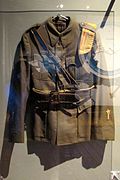Museum of Mexico City
[3] The museum contains a number of elements of the old palace as well as 26 rooms dedicated to the history and development of Mexico City from Aztec times to the present.[6] The history of the Old Palace of the Counts of Santiago de Calimaya dates back to the year 1527, when Mr. Juan Gutiérrez Altamirano arrived in New Spain from the island of Cuba, where he had been governor in 1524; to take the post of Corregidor of Texcoco and overseer of Hernán Cortés.The counts suffered financial difficulties at this time, but their status as nobles enabled them to get the audiencia to allow them to tax their lands, so that they would obtain money for the rebuilding of their palace.In the colonial era, calle de Pino Suárez (at that time, Iztapalapa road) was the fashionable street for the houses of the nobility, which were thus aligned with the Royal Palace.At this time, the viceregal government decided to renovate the deteriorated palace in 1777, giving the work to Francisco Antonio Guerrero y Torres,[7] putting a lien on the building's rental income.It is thought that the head may have come from the Templo Mayor and was placed as the cornerstone of the original house that was owned by Juan Gutierrez Altamirano [es].This house was adapted to rent space to lower-class tenants and by end of the 1950s had become tenements, in spite of the fact that it had been declared a national monument in 1931.The colonial-era, 19th and 20th century rooms also contain everyday items from these time periods such as furniture, desks, tables, vases, and jars as well as arts such as sculptures and paintings.Clausell received visitors in these rooms such as Gerardo Murillo (Dr. Atl), Diego Rivera, Carlos Pellicer, Salvador Novo and Julio Ruelas.The rooms contain 1,300 sketches by the artist including portraits of famous people, images of Christ, angels and animals and mythological scenes.[3] There are also temporary exhibits, educational programs for children and adults, a room devoted to the river system in the Valley of Mexico, a bookstore, and guided tours.[11] One of the events recently held here was called "Beats & Bits," which traced the origins of electronic music from the beginnings of the 20th century to the present.







Historic center of Mexico CityMexico CityCoordinatesHistory museumFrancisco Guerrero y TorresZócalo/Tenochtitlan metro stationSistema de Transporte ColectivoSpanishZocaloHernán CortésMoctezuma IIAztec timesJoaquín ClausellFrancisco Antonio de Guerrero y TorresNew SpainTexcocoTemplo MayorCalimayaLuis de VelascoPhilip III of SpainBourbon reformsaudienciaCriolloPalace of the Marquises of Jaral del BerrioRoyal PalacetezontleFrancisco Antonio Guerrero y TorressacristiesMassesHugo BrehmefriezesbasaltBaroquemascaronsgargoylesMexicoNereidPhilippinesFranz SchubertChopinBeethovenMexican composersAniceto OrtegaMelesio MoralesPedro Ramírez VázquezMuseo Nacional de AntropologíaMuseo de Arte ModernoMuseo de VirreinatoMuseo del CaracolAna UgaldemetatesAztec codicesCampecheGerardo MurilloDiego RiveraCarlos PellicerSalvador NovoJulio RuelasImpressionismSymbolismMuseo Nacional de ArteJaime Torres BodetValley of Mexicoelectronic musiclucha libreCuauhtémoc Cárdenas SolórzanoPope John Paul IIInstituto Nacional de Antropología e HistoriaZócaloAdministrative buildingsMetropolitan CathedralCruz de MañozcaFountain to Bartolomé de las CasasMonument to Pope John Paul IINacional Monte de PiedadNational PalaceOld Portal de MercaderesAcademia Mexicana de la HistoriaAcademy of San CarlosAntigua Escuela de JurisprudenciaColegio de San Ignacio de Loyola VizcaínasEl Colegio NacionalUniversity of the Cloister of Sor JuanaLibrary of the Congress of MexicoOld Customs BuildingPalace of the Marqués del ApartadoSecretariat of Public Education Main HeadquartersSupreme Court of Justice of the NationChurch of San Felipe Neri "La Profesa"Church of San HipólitoChurch of Santa InésConvent of La MercedConvent of San FranciscoConvent of Santa InésCorpus Christi ChurchHistoric Synagogue Justo Sierra 71Iglesia de San BernardoLa Enseñanza ChurchLa Santísima ChurchNuestra Señora de Loreto ChurchRegina Coeli Convent ChurchRoyal Convent of Jesús María and Our Lady of MercySanta Teresa la AntiguaSanta Veracruz MonasterySanto DomingoTemplo Expiatorio Nacional de San Felipe de JesúsValvanera CathedralCaricature MuseumCasa Talavera Cultural CenterCentro Cultural de EspañaColegio de San IldefonsoFranz Mayer MuseumHouse of the First Print Shop in the AmericasInteractive Museum of EconomicsJosé Luis Cuevas MuseumMuseo de Arte PopularMuseo de CharreríaMuseo de la Secretaría de Hacienda y Crédito PúblicoMuseo del EstanquilloMuseo Mural Diego RiveraMuseo Nacional de la EstampaMuseo Nacional de las CulturasMuseum of LightPalace of the InquisitionPalacio de MineríaSan Pedro y San Pablo College